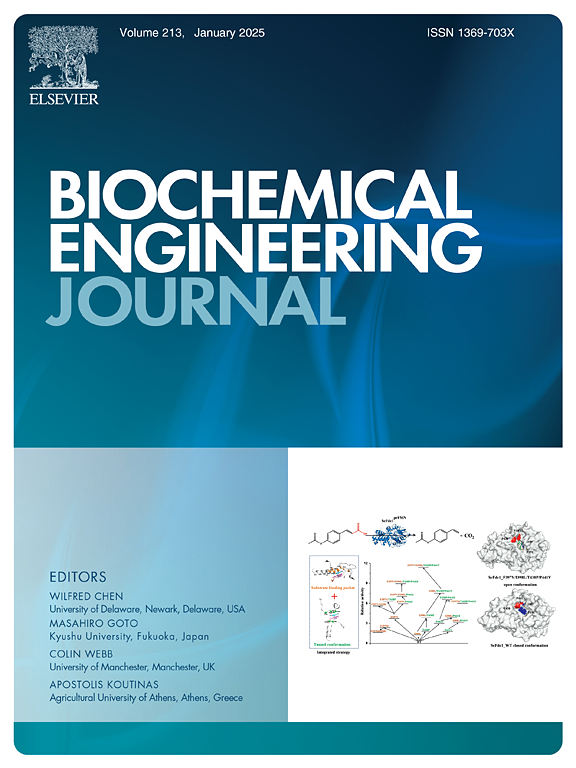Unlocking the application potential of transaminases: Improving thermal and pH stability of transaminase from Vibrio fluvialis through random mutagenesis
IF 3.7
3区 生物学
Q2 BIOTECHNOLOGY & APPLIED MICROBIOLOGY
引用次数: 0
Abstract
Transaminase from Vibrio fluvialis (Vfat) is a suitable enzyme for chiral amine synthesis due to its strict enantioselectivity and broad specificity for amine donors. However, like other transaminases, Vfat faces several operational challenges, particularly its stability under pH and temperature conditions— challenges could be addressed through the random mutagenesis strategy. In our research, we successfully improved two key operational properties of Vfat through random mutagenesis. A critical step in this process was developing and applying a lysis buffer, which enabled high-throughput screening in 96-well microplates. Vfat random mutagenesis library was generated through ep PCR, and the resulting library was cloned into pET28α(+)_Vfat using the MEGAWHOP method (Megaprimer PCR of Whole Plasmid). After overcoming the challenges of lysis and cloning, a library was constructed with 35 96-well microtiter plates with a mutation frequency of 2 kb−1. Variants with outstanding performance in initial activity (up to five times higher than the wild-type enzyme) and better performance at temperature challenge (six-fold increase) and in alkaline pH (retaining initial activity after incubation) were obtained. This improvement highlights the potential of random mutagenesis in this enzyme, a tool not explored in transaminases. Using a lysis buffer allowed efficient screening, thus obtaining active enzyme variants. These advances represent a significant step in using high-throughput platforms to optimize transaminases.
释放转氨酶的应用潜力:通过随机诱变提高河流弧菌转氨酶的热稳定性和pH稳定性
河流弧菌(Vibrio fluvialis, Vfat)转氨酶对胺供体具有严格的对映选择性和广泛的特异性,是一种适合手性胺合成的酶。然而,像其他转氨酶一样,Vfat面临着一些操作上的挑战,特别是它在pH和温度条件下的稳定性——这些挑战可以通过随机诱变策略来解决。在我们的研究中,我们通过随机诱变成功地改善了Vfat的两个关键操作特性。该过程的关键步骤是开发和应用裂解缓冲液,使96孔微孔板的高通量筛选成为可能。通过ep PCR生成Vfat随机突变文库,利用MEGAWHOP (Megaprimer PCR of Whole Plasmid)方法将文库克隆到pET28α(+)_Vfat中。克服了裂解和克隆的困难,构建了35个96孔微滴板的文库,突变频率为2 kb−1。获得了具有出色的初始活性(比野生型酶高5倍)和更好的温度挑战性能(提高6倍)和碱性(孵育后保持初始活性)的变体。这一改进突出了这种酶的随机诱变的潜力,这是一种未在转氨酶中探索的工具。使用裂解缓冲液可以有效筛选,从而获得活性酶变体。这些进展代表了使用高通量平台优化转氨酶的重要一步。
本文章由计算机程序翻译,如有差异,请以英文原文为准。
求助全文
约1分钟内获得全文
求助全文
来源期刊

Biochemical Engineering Journal
工程技术-工程:化工
CiteScore
7.10
自引率
5.10%
发文量
380
审稿时长
34 days
期刊介绍:
The Biochemical Engineering Journal aims to promote progress in the crucial chemical engineering aspects of the development of biological processes associated with everything from raw materials preparation to product recovery relevant to industries as diverse as medical/healthcare, industrial biotechnology, and environmental biotechnology.
The Journal welcomes full length original research papers, short communications, and review papers* in the following research fields:
Biocatalysis (enzyme or microbial) and biotransformations, including immobilized biocatalyst preparation and kinetics
Biosensors and Biodevices including biofabrication and novel fuel cell development
Bioseparations including scale-up and protein refolding/renaturation
Environmental Bioengineering including bioconversion, bioremediation, and microbial fuel cells
Bioreactor Systems including characterization, optimization and scale-up
Bioresources and Biorefinery Engineering including biomass conversion, biofuels, bioenergy, and optimization
Industrial Biotechnology including specialty chemicals, platform chemicals and neutraceuticals
Biomaterials and Tissue Engineering including bioartificial organs, cell encapsulation, and controlled release
Cell Culture Engineering (plant, animal or insect cells) including viral vectors, monoclonal antibodies, recombinant proteins, vaccines, and secondary metabolites
Cell Therapies and Stem Cells including pluripotent, mesenchymal and hematopoietic stem cells; immunotherapies; tissue-specific differentiation; and cryopreservation
Metabolic Engineering, Systems and Synthetic Biology including OMICS, bioinformatics, in silico biology, and metabolic flux analysis
Protein Engineering including enzyme engineering and directed evolution.
 求助内容:
求助内容: 应助结果提醒方式:
应助结果提醒方式:


